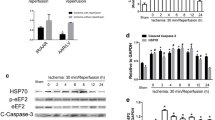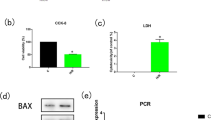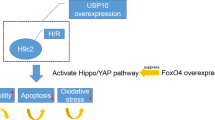Abstract
Heat shock transcription factor-1 (HSF1) protects against cardiac diseases such as ischemia/reperfusion injury and myocardial infarction. However, the mechanisms have not yet been fully characterized. In this study, we investigated the effects of reactive oxygen species (ROS) and apoptosis signal-regulating kinase-1 (ASK1) in HSF1-regulated cardiomyocyte protection. Cultured cardiomyocytes of neonatal rats were transfected with HSF1, ASK1 or both of them before exposure to H2O2, and the ROS generation, c-Jun N-terminal kinase (JNK) activity and apoptosis were examined. H2O2 significantly increased intracellular ROS generation and apoptotic cells as expected, and all these cellular events were greatly inhibited by overexpression of HSF1. However, H2O2-induced increases in JNK phosphorylation and cell apoptosis were largely enhanced by ASK1 overexpression whereas the similar transfection did not affect the ROS generation in the cells. Moreover, inhibition of H2O2-increased ROS generation, JNK phosphorylation, and cellular apoptosis by overexpression of HSF1 tended to be disappeared, when the cells were co-transfected with ASK1. These results suggest that HSF1 protects cardiomyocytes from apoptosis under oxidative stress via down-regulation of intracellular ROS generation and inhibition of JNK phosphorylation. Although ASK1 itself has no effect on intracellular ROS generation, it may affect the inhibitory effects of HSF1 on ROS generation, JNK activity, and cardiomyocyte injury.




Similar content being viewed by others
References
Westerheide SD, Morimoto RI (2005) Heat shock response modulators as therapeutic tools for diseases of protein conformation. J Biol Chem 280:33097–33100
Santoro MG (2000) Heat shock factors and the control of the stress response. Biochem Pharmacol 59:55–63
Zou Y, Zhu W, Sakamoto M et al (2003) Heat shock transcription factor 1 protects cardiomyocytes from ischemia/reperfusion injury. Circulation 108:3024–3030
Baljinnyam E, Hasebe N, Morihira M et al (2006) Oral pretreatment with ebselen enhances heat shock protein 72 expression and reduces myocardial infarct size. Hypertens Res 29:905–913
Brundel BJ, Shiroshita-Takeshita A, Qi X et al (2006) Induction of heat shock response protects the heart against atrial fibrillation. Circ Res 99:1394–1402
Venkatakrishnan CD, Tewari AK, Moldovan L et al (2006) Heat shock protects cardiac cells from doxorubicin-induced toxicity by activating p38 MAPK and phosphorylation of small heat shock protein 27. Am J Physiol Heart Circ Physiol 291:H2680–H2691
Wakisaka O, Takahashi N, Shinohara T et al (2007) Hyperthermia treatment prevents angiotensin II-mediated atrial fibrosis and fibrillation via induction of heat-shock protein 72. J Mol Cell Cardiol 43:616–626
Martindale JL, Holbrook NJ (2002) Cellular response to oxidative stress: signaling for suicide and survival. J Cell Physiol 192:1–15
Yodoi J, Masutani H, Nakamura H (2001) Redox regulation by the human thioredoxin system. Biofactors 15:107–111
Matsuzawa A, Ichijo H (2008) Redox control of cell fate by MAP kinase: physiological roles of ASK1-MAP kinase pathway in stress signaling. Biochim Biophys Acta 1780:1325–1336
Machino T, Hashimoto S, Maruoka S et al (2003) Apoptosis signal-regulating kinase 1-mediated signaling pathway regulates hydrogen peroxide-induced apoptosis in human pulmonary vascular endothelial cells. Crit Care Med 31:2776–2781
Yamaguchi O, Higuchi Y, Hirotani S et al (2003) Targeted deletion of apoptosis signal-regulating kinase 1 attenuates left ventricular remodeling. Proc Natl Acad Sci USA 100:15883–15888
Sano M, Fukuda K, Sato T et al (2001) ERK and p38 MAPK, but not NF-kappa B, are critically involved in reactive oxygen species-mediated induction of IL-6 by angiotensin II in cardiac fibroblasts. Circ Res 89:661–669
Jang JH, Surh YJ (2002) Beta-amyloid induces oxidative DNA damage and cell death through activation of c-Jun N terminal kinase. Ann N Y Acad Sci 973:228–236
Kyriakis JM, Avruch J (2001) Mammalian mitogen-activated protein kinase signal transduction pathways activated by stress and inflammation. Physiol Rev 81:807–869
Yan LJ, Rajasekaran NS, Sathyanarayanan S et al (2005) Mouse HSF1 disruption perturbs redox state and increases mitochondrial oxidative stress in kidney. Antioxid Redox Signal 7:465–471
Xiao X, Benjamin IJ (1999) Stress-response proteins in cardiovascular disease. Am J Hum Genet 64:685–690
Murapa P, Gandhapudi S, Skaggs HS et al (2007) Physiological fever temperature induces a protective stress response in T lymphocytes mediated by heat shock factor-1 (HSF1). J Immunol 179:8305–8312
Li X, Luo Y, Yu L et al (2008) SENP1 mediates TNF-induced desumoylation and cytoplasmic translocation of HIPK1 to enhance ASK1-dependent apoptosis. Cell Death Differ 15:739–750
Tobiume K, Matsuzawa A, Takahashi T et al (2001) ASK1 is required for sustained activations of JNK/p38 MAP kinases and apoptosis. EMBO Rep 2:222–228
Pasumarthi KB, Kardami E, Cattini PA (1996) High and low molecular weight fibroblast growth factor-2 increase proliferation of neonatal rat cardiac myocytes have differential effects on binucleation and nuclear morphology. Evidence for both paracrine and intracrine actions of fibroblast growth factor-2. Circ Res 78(1):126–136
Nakai A, Tanabe M, Kawazoe Y, Inazawa J, Morimoto RI, Nagata K (1997) HSF4, a new member of the human heat shock factor family which lacks properties of a transcriptional activator. Mol Cell Biol 17(1):469–481
Ando K (2003) Oxidative stress. Nippon Rinsho 61:1130–1137
Jacquier-Sarlin MR, Polla BS (1996) Dual regulation of heat-shock transcription factor (HSF) activation and DNA-binding activity by H2O2: role of thioredoxin. Biochem J 318:187–193
Ungvari Z, Gupte SA, Recchia FA et al (2005) Role of oxidative-nitrosative stress and downstream pathways in various forms of cardiomyopathy and heart failure. Curr Vasc Pharmacol 3:221–229
Fernandes MA, Marques RJ, Vicente JA et al (2008) Sildenafil citrate concentrations not affecting oxidative phosphorylation depress H2O2 generation by rat heart mitochondria. Mol Cell Biochem 309:77–85
McMillan DR, Xiao X, Shao L et al (1998) Targeted disruption of heat shock transcription factor 1 abolishes thermotolerance and protection against heat-inducible apoptosis. J Biol Chem 273:7523–7528
Sakamoto M, Minamino T, Toko H et al (2006) Upregulation of heat shock transcription factor 1 plays a critical role in adaptive cardiac hypertrophy. Circ Res 99:1411–1418
Jacquier-sarlin MR, Jornot L, Polla BS (1995) Differential expression and regulation of hsp70 and hsp90 by phorbol esters and heat shock. J Biol Chem 270:14094–14099
Sistonen L, Sarge KD, Morimoto RI (1994) Human heat shock factors 1 and 2 are differentially activated and can synergistically induce hsp70 gene transcription. Mol Cell Biol 14:2087–2099
Mehlen P, Kretz-Remy C, Preville X et al (1996) Human hsp27, Drosophila hsp27 and human alphaB-crystallin expression-mediated increase in glutathione is essential for the protective activity of these proteins against TNFalpha-induced cell death. EMBO J 15:2695–2706
Ravingerova T, Barancik M, Strniskova M (2003) Mitogen-activated protein kinases: A new therapeutic target in cardiac pathology. Mol Cell Biochem 247:127–138
Guyton KZ, Liu Y, Gorospe M et al (1996) Activation of mitogen-activated protein kinase by H2O2. Role in cell survival following oxidant injury. J Biol Chem 271:4138–4142
Matsuzawa A, Nishitoh H, Tobiume K et al (2002) Physiological roles of ASK1-mediated signal transduction in oxidative stress- and endoplasmic reticulum stress-induced apoptosis: advanced findings from ASK1 knockout mice. Antioxid Redox Signal 4:415–425
Van Laethem A, Nys K, Van Kelst S et al (2006) Apoptosis signal regulating kinase-1 connects reactive oxygen species to p38 MAPK-induced mitochondrial apoptosis in UVB-irradiated human keratinocytes. Free Radic Biol Med 41:1361–1371
Goldman EH, Chen L, Fu H (2004) Activation of apoptosis signal-regulating kinase 1 by reactive oxygen species through dephosphorylation at serine 967 and 14-3-3 dissociation. J Biol Chem 279:10442–10449
Acknowledgments
We thank Mr. Guoping Zhang at Institutes of Biomedical Sciences, Fudan University, China for flow cytometry analysis and Dr. Issei Komuro at Chiba University Graduate School of Medicine, Japan for kindly providing the plasmids. This work was supported by National Natural Science Foundation of China (No. 30570741, No. 30871073 and No. 30930043).
Disclosures
None.
Author information
Authors and Affiliations
Corresponding authors
Additional information
Lei Zhang, Hong Jiang, in order to and Xiaoqing Gao authors contributed equally to this work.
Rights and permissions
About this article
Cite this article
Zhang, L., Jiang, H., Gao, X. et al. Heat shock transcription factor-1 inhibits H2O2-induced apoptosis via down-regulation of reactive oxygen species in cardiac myocytes. Mol Cell Biochem 347, 21–28 (2011). https://doi.org/10.1007/s11010-010-0608-1
Received:
Accepted:
Published:
Issue Date:
DOI: https://doi.org/10.1007/s11010-010-0608-1




